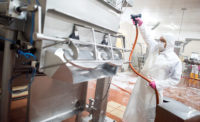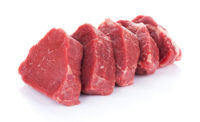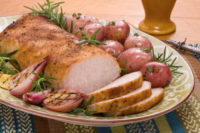Skinners Get Some Teeth
The skinner: until recently, an essential but largely unchanged aspect of the meat and poultry production process. Many companies, in fact, still offer some equipment that was designed almost three decades ago. However, while operations may have stayed consistent, today many skinner suppliers have tweaked their products to offer greater automation, worker safety, product yield and less labor.
For many poultry items, the skin is very lightly attached to the body and easily removed. Where necessary, it can often be done by hand. The beef industry, however, requires more high-tech machines to remove fat and skin for increasingly customized products.
State-of-the-art automated skinners now have the ability to scan the product and skin and/or de-fat to predetermined parameters, thus giving the maximum possible yields, says Dave Atcherley, president of Dunmore, Pa.-based Skinner Systems, the exclusive U.S. and Canadian distributor for the Grasselli Co., a manufacturer of skinning machines and slicing systems for the meat, poultry and fish industries. “Previously these operations were labor intensive, inaccurate and involved potentially dangerous machines,” he says.
Manufacturing technology has advanced to the point that skinner manufacturers can produce skinners that would have been impossible five to 10 years ago, says Atcherley. The new wave of skinners are stronger, have less moving parts, much increased longevity and improved cutting accuracy without major price increases.
In addition, modern manufacturing techniques utilize totally stainless materials, cast or machined alloys. Plastics and other materials are indeed no longer necessary. The change in materials and techniques combines to give previously unattainable sanitary standards.
“The past couple of decades have seen major advances in operator safety on open top [manual] skinning machines, cumulating in the unique Grasselli CLO wireless operator safety system,” says Atcherley. “A system that protects the operators of manual Grasselli ham and membrane skinners from the risk of potentially serous injury.”
In addition, Weber’s new ASX 460 Automatic Fat Remover and Derinding Machine, developed for pork loins, has several operating modes but most commonly is set for automatic. In the automatic operating mode, the first step is to determine how much of a fat layer needs to be left on the pork loin, which is determined by the individual company’s specifications, says Albrecht. On the computer screen, the operator will set up his or her fat thickness. The pork loin is then placed fat side down on the camera belt. The fat layer thickness of the product is measured and evaluated by the camera. The blade holder automatically sets the required cutting depth. The de-fatted loin will move onto the next process via a conveyor belt.
The second step is the derinding process, notes Albrecht. The fat that was removed from the pork loin will drop onto a second conveyor belt rind side down and will feed into a Weber Derinder. The Weber derinder will be set to a thickness from 0 to 4 millimeters by the operator and the rind will be separated from the fat.
In the manual operating mode, the operator will set the thickness of the fat layer which he or she will remove from the pork loin, says Albrecht.
Its solid industrial membrane skinner (pellicle remover), for example, is strong, hygienic and accurately built to increase high yields. In addition, it comes equipped with a compressed air cleaning system with a built-in microfilter to ensure worker safety.
“We’re always trying to make our machines safer and more hygienic,” says Cauwels. “That’s the main core of our R&D.” Cretel also offers hygienic equipment for plants, such as industrial tunnel washing machines, tray washers, and sole, shoe and boot washers, to reinforce food safety.
“The skinners are improved, but could be improved more by making the machines more versatile, such as by enabling more species to be added as with fish,” says Cauwels.
MAJA, an international manufacturer of de-rinding, membrane-skinning and automatic flake-ice machinery, based in Omaha, Neb., is also featuring products that are more automated, which allows them to handle more product, increase plant safety and reduce man power. Its computer-controlled membrane skinners facilitate a smooth process: the operator simply puts the product on the belt, the item is moved across the tooth roller, and it’s ejected from the machine. More product can be put on the in-feed belt, as well. The computers enables operators to set the amount of time the product will be over the blades, cycles, and adapt the operation to the product involved.
With the MAJA EVM 4004 and 4006 manual skinning machines, for example, the tooth-roller cleaning system operates with compressed air but without air control valves, allowing for a more flexible installation and eliminating the risk of air valves freezing.
MAJA’s “tool-less” blade-holder allows for fast, easy and safe blade changes without removing it from the machine.
According to Paul Menting, general manager, MAJA’s automatic machines can reduce manpower by up to two to three people, depending on the application “These skinners are also safer, faster, more durable and wider” over their predecessors, he says. “We have improved the electrical components in our machines, and they have a stouter framework.”
Menting notes that there are automatic skinners available today that skin as well as slice, creating products from products such as beef skirts — good for fajitas — flank steaks and tri-tips, etc. “MAJA has had great success with these products with super mercados [Hispanic grocery stores],” he says.
With one model of automatic skinner, the operator is able to skin one side of a flat product, have the product returned, flip it over and skin the other side. Products can also be horizontally sliced after being skinned, and round product can also be sliced length ways from one-quarter to three-quarter inch thickness, says Menting. “Manual pork-butt skinners for shoulders are less used today for safety factors, because the top blade can be dangerous if the operator is not paying attention,” he says. “The bottom blade holder removes the skin and the top blade holder removes the fat on the shoulder.”
New pork-belly skinners from MAJA now have better initial cuts. The initial cut is critical to how well the remainder of the belly will skin.
Tooth rollers have also had their fair share of improvements. Rows of teeth on the tooth-roller are no longer interrupted by grooves needed to mechanically clean the roller because, as mentioned earlier, compressed air has taken over this role. Teeth are now finer to produce consistently high yields when removing membrane.
Despite these recent advancements, Menting notes more automation can still come about for skinners. Some automatic machines produced today are too large and too expensive for plant floors that are already facing crowded conditions. Continued progress in the automation of skinners for smaller production areas or applications is needed, such as with butt or ham lines (in the case of pork products).
“More automated machines would allow us to reduce man power,” says Menting. “The pool of manpower is dwindling because it’s difficult to find people who will do these jobs and because of continued difficulties with an immigrating workforce.”
Menting notes that one ham may look like another, but its weight, fat and exterior conformation can be different. How do you teach a robot, after all, a standardized program to remove the skin and fat off ham when each one is unique? Menting predicts the latest vision and sonic technology might be employed to direct the robot arm.
For many poultry items, the skin is very lightly attached to the body and easily removed. Where necessary, it can often be done by hand. The beef industry, however, requires more high-tech machines to remove fat and skin for increasingly customized products.
State-of-the-art automated skinners now have the ability to scan the product and skin and/or de-fat to predetermined parameters, thus giving the maximum possible yields, says Dave Atcherley, president of Dunmore, Pa.-based Skinner Systems, the exclusive U.S. and Canadian distributor for the Grasselli Co., a manufacturer of skinning machines and slicing systems for the meat, poultry and fish industries. “Previously these operations were labor intensive, inaccurate and involved potentially dangerous machines,” he says.
Manufacturing technology has advanced to the point that skinner manufacturers can produce skinners that would have been impossible five to 10 years ago, says Atcherley. The new wave of skinners are stronger, have less moving parts, much increased longevity and improved cutting accuracy without major price increases.
In addition, modern manufacturing techniques utilize totally stainless materials, cast or machined alloys. Plastics and other materials are indeed no longer necessary. The change in materials and techniques combines to give previously unattainable sanitary standards.
“The past couple of decades have seen major advances in operator safety on open top [manual] skinning machines, cumulating in the unique Grasselli CLO wireless operator safety system,” says Atcherley. “A system that protects the operators of manual Grasselli ham and membrane skinners from the risk of potentially serous injury.”
Improving operations
Weber North America has been updating its machines features for the convenience and ergonomic benefit of their operators. Recently, the Kansas City, Mo.-based company created a Tool Less Blade Holder and a Height Adjustment for its manual machines. The Tool Less Blade Holder allows for the quick change of a blade without the need of tools. And the height adjustment can be raised or lowered to fit the individual operator, improving ergonomic design, says Terry Albrecht, product manager for Weber’s line of skinners, derinders and ice-flaking machines.In addition, Weber’s new ASX 460 Automatic Fat Remover and Derinding Machine, developed for pork loins, has several operating modes but most commonly is set for automatic. In the automatic operating mode, the first step is to determine how much of a fat layer needs to be left on the pork loin, which is determined by the individual company’s specifications, says Albrecht. On the computer screen, the operator will set up his or her fat thickness. The pork loin is then placed fat side down on the camera belt. The fat layer thickness of the product is measured and evaluated by the camera. The blade holder automatically sets the required cutting depth. The de-fatted loin will move onto the next process via a conveyor belt.
The second step is the derinding process, notes Albrecht. The fat that was removed from the pork loin will drop onto a second conveyor belt rind side down and will feed into a Weber Derinder. The Weber derinder will be set to a thickness from 0 to 4 millimeters by the operator and the rind will be separated from the fat.
In the manual operating mode, the operator will set the thickness of the fat layer which he or she will remove from the pork loin, says Albrecht.
Safety comes first
Cretel, an international poultry, meat and fish skinner membrane skinning and derinding supplier, is increasingly moving away from hand-fed machines to automatic machines for their improved safety features, regardless of the size of the machine, says Alexander Cauwels, president of Cretal North America Inc., Robbinsville, N.J. The company offers a range of machines from compact, stainless-steel table-top models to industrial machines, and completely automatic solutions with in- and outfeed conveyors.Its solid industrial membrane skinner (pellicle remover), for example, is strong, hygienic and accurately built to increase high yields. In addition, it comes equipped with a compressed air cleaning system with a built-in microfilter to ensure worker safety.
“We’re always trying to make our machines safer and more hygienic,” says Cauwels. “That’s the main core of our R&D.” Cretel also offers hygienic equipment for plants, such as industrial tunnel washing machines, tray washers, and sole, shoe and boot washers, to reinforce food safety.
“The skinners are improved, but could be improved more by making the machines more versatile, such as by enabling more species to be added as with fish,” says Cauwels.
MAJA, an international manufacturer of de-rinding, membrane-skinning and automatic flake-ice machinery, based in Omaha, Neb., is also featuring products that are more automated, which allows them to handle more product, increase plant safety and reduce man power. Its computer-controlled membrane skinners facilitate a smooth process: the operator simply puts the product on the belt, the item is moved across the tooth roller, and it’s ejected from the machine. More product can be put on the in-feed belt, as well. The computers enables operators to set the amount of time the product will be over the blades, cycles, and adapt the operation to the product involved.
With the MAJA EVM 4004 and 4006 manual skinning machines, for example, the tooth-roller cleaning system operates with compressed air but without air control valves, allowing for a more flexible installation and eliminating the risk of air valves freezing.
MAJA’s “tool-less” blade-holder allows for fast, easy and safe blade changes without removing it from the machine.
According to Paul Menting, general manager, MAJA’s automatic machines can reduce manpower by up to two to three people, depending on the application “These skinners are also safer, faster, more durable and wider” over their predecessors, he says. “We have improved the electrical components in our machines, and they have a stouter framework.”
Menting notes that there are automatic skinners available today that skin as well as slice, creating products from products such as beef skirts — good for fajitas — flank steaks and tri-tips, etc. “MAJA has had great success with these products with super mercados [Hispanic grocery stores],” he says.
With one model of automatic skinner, the operator is able to skin one side of a flat product, have the product returned, flip it over and skin the other side. Products can also be horizontally sliced after being skinned, and round product can also be sliced length ways from one-quarter to three-quarter inch thickness, says Menting. “Manual pork-butt skinners for shoulders are less used today for safety factors, because the top blade can be dangerous if the operator is not paying attention,” he says. “The bottom blade holder removes the skin and the top blade holder removes the fat on the shoulder.”
New pork-belly skinners from MAJA now have better initial cuts. The initial cut is critical to how well the remainder of the belly will skin.
Tooth rollers have also had their fair share of improvements. Rows of teeth on the tooth-roller are no longer interrupted by grooves needed to mechanically clean the roller because, as mentioned earlier, compressed air has taken over this role. Teeth are now finer to produce consistently high yields when removing membrane.
Despite these recent advancements, Menting notes more automation can still come about for skinners. Some automatic machines produced today are too large and too expensive for plant floors that are already facing crowded conditions. Continued progress in the automation of skinners for smaller production areas or applications is needed, such as with butt or ham lines (in the case of pork products).
“More automated machines would allow us to reduce man power,” says Menting. “The pool of manpower is dwindling because it’s difficult to find people who will do these jobs and because of continued difficulties with an immigrating workforce.”
Looking ahead
In about ten years, Menting fully expects to see a viable robotic alternative to the current skinner machines, if a large meat processor is willing to take that leap of faith and partner with an equipment manufacturer. “This investment will help processors produce less expensive operations with the use of robotics, providing increased safety and decreasing the need for manpower,” he says. “It’s going to be a difficult process because in the meat industry you’re dealing with a dynamic product as compared to the auto industry, where robotics have been used for years, which can use rote types of movement.”Menting notes that one ham may look like another, but its weight, fat and exterior conformation can be different. How do you teach a robot, after all, a standardized program to remove the skin and fat off ham when each one is unique? Menting predicts the latest vision and sonic technology might be employed to direct the robot arm.
Not hiding anything
Not all meat products go through skinners. For the past 50 years, dehiders have also been used to skin product. In fact, they are the number one skinning tool worldwide for cattle, veal, hogs and sheep. They are high-capacity, high-performance tools, designed for long life and low maintenance, creating quality hides with no cuts, marks or holes. Today’s tools from Middletown, Ct.-based Jarvis Products, for example, now feature two blades instead of one, and feature improved torque and balance vibration. Dehiders have an efficient motor design with an extra-thin head with a stainless steel center plate for easy handling and strength.Looking for a reprint of this article?
From high-res PDFs to custom plaques, order your copy today!






